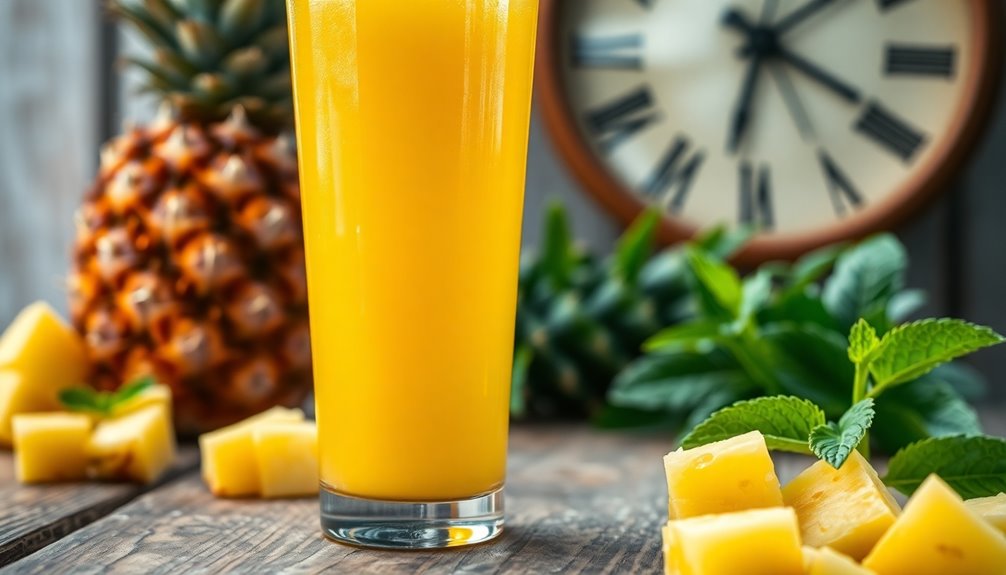Pineapple juice shouldn't sit out at room temperature for more than two hours. If it's hotter than 90°F (32°C), limit that time to one hour. Beyond these timeframes, the risk of spoilage and bacterial growth increases significantly, making it unsafe to drink. Always check for signs of spoilage, like off smells or sediment. Want to know how to store it properly and keep it fresh? There's more important info ahead!
Key Takeaways
- Pineapple juice should be consumed within two hours of pouring at room temperature.
- If the temperature exceeds 90°F (32°C), consume the juice within one hour.
- Discard any juice left out overnight to prevent foodborne illnesses.
- Always check for signs of spoilage before consuming any juice that has been sitting out.
- Proper storage in the refrigerator extends the juice's freshness and reduces spoilage risk.

When you pour yourself a refreshing glass of pineapple juice, it's important to remember that it shouldn't sit out for too long. Pineapple juice, like many other juices, can be a breeding ground for bacteria if left at room temperature. Ideally, you should consume your juice within two hours of pouring. If the temperature rises above 90°F or 32°C, this window shrinks to just one hour. Beyond that, the safe-to-drink status of your juice diminishes significantly.
You might think that the high acidity of pineapple juice helps preserve it, and while it does slow spoilage, it doesn't completely eliminate the risk. Harmful bacteria can still multiply in acidic environments, especially if the juice is left out for an extended period. If you happen to forget your glass on the counter overnight, it's best to err on the side of caution and discard it. The risk of foodborne illnesses isn't worth the chance of a few extra sips.
When you're enjoying pineapple juice, always be mindful of the signs of spoilage. These can include changes in color, an off smell, or a strange taste. If your juice looks cloudy or has developed any sediment, it's a definite sign that it's time to toss it.
Checking the expiration date on the bottle is also crucial; once opened, the juice should be refrigerated promptly. Leaving it out can lead to rapid bacterial growth that compromises the juice's quality and safety.
If you want to keep your pineapple juice safe for consumption, store it in the refrigerator as soon as you finish pouring. This practice helps maintain its freshness and flavor while reducing the risk of spoilage. An opened bottle of pineapple juice typically lasts about seven to ten days in the fridge, but always check for any signs of spoilage before enjoying it.
Frequently Asked Questions
How Long Can Pineapple Juice Last Out of the Fridge?
When you leave pineapple juice out of the fridge, it can quickly become unsafe to drink. Ideally, you shouldn't let it sit out for more than two hours at room temperature.
If the temperature's above 90°F, it's best to discard it after just one hour. Always check for off odors, flavors, or any changes in appearance before consuming.
If it's been out overnight, throw it away to avoid any risk of foodborne illness.
Is Juice Ok if Left Out Overnight?
If you've left juice out overnight, it's best to toss it.
Even though the high acidity might slow bacterial growth, it doesn't stop it completely. You wouldn't want to risk consuming spoiled juice, as it could lead to unpleasant tastes or even foodborne illnesses.
To stay safe, always refrigerate your juice promptly after using it and stick to proper storage guidelines. Your health's worth it!
How Long Can Pineapple Go Unrefrigerated?
Leaving pineapple unrefrigerated is like letting a ticking time bomb sit around; it can be risky.
You shouldn't let it sit out for more than two hours at room temperature, as bacteria can start multiplying quickly.
Even though its acidity can slow spoilage, you'll still notice off flavors and reduced quality after extended time.
For the best taste and safety, always store pineapple in the fridge once it's opened.
How Long Can You Keep Fresh Juice From a Juicer?
You should drink fresh juice from a juicer within 24 hours for the best taste and nutrient retention.
If you refrigerate it, it can last up to 2 to 3 days, but its quality will drop significantly after the first day.
To keep it fresh longer, consider freezing your juice in airtight containers, which allows it to last for 8 to 12 months without losing much of its flavor or nutrients.
Conclusion
So, when it comes to pineapple juice, remember it's best to keep it cozy in the fridge. If it's been sitting out, treat it like a wilting flower—after two hours, it's time to say goodbye. The sweet golden nectar can quickly turn sour, losing its vibrant charm and inviting taste. Keep your juice fresh and flavorful, and don't let it linger too long in the warm embrace of the room—it deserves a chilled haven!
Cindy thoroughly researches juicing trends, techniques, and recipes to provide readers with practical advice and inspiration. Her writing style is accessible, engaging, and designed to make complex concepts easy to understand. Cindy’s dedication to promoting the advantages of juicing shines through her work, empowering readers to make positive changes in their lives through the simple act of juicing.











